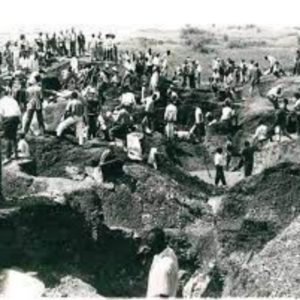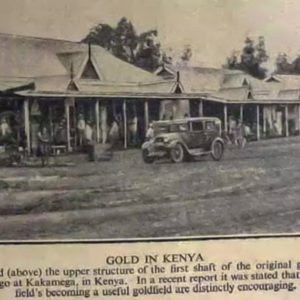Kakamega Gold Rush

Image credit: twitter/@HistoryKe

Prospectors mining gold in Kakamega. Image credit: Safaricom Newsroom
When Louis Andrew Johnson moved from the United States of America to settle on a cliff in Turbo, Kenya, he never knew that his actions would set off one of the biggest movements in the country.
Louis and his wife lived in Turbo as excellent hosts before the coming of the railway to the town. In 1930, they embarked on a prospecting expedition to northern Tanganyika with two other Europeans and five Africans. Their expedition was futile as maize prices plummeted and their farms were left in ruins. On their way back, they stopped at Kakamega near the Yala River. With nothing to lose, Louis had the idea of mining in the river to see if fortune would favour them. To their surprise, they found gold flecks. It was a literal gold mine and this discovery prompted Louis and his team to get money from lenders to start the mining process properly thus kicking off the Kakamega Gold Rush.
This was during The Great Depression (1929-1940) and many people around the world were selling their belongings in large numbers to ensure their survival. In Kenya many settlers, heard about prospective gold, and moved in droves to get their own share of the golden goose in the sleepy town.
Setting Up Frameworks
The town received around 1,000 prospectors just a few months within Louis’s ground-breaking discovery. It was booming. The colonial government took note of this boom and stepped in to set some ground rules to regulate the entire industry. This was also done because the discovery of gold was in an area inhabited by Africans. The rush itself brought one other kind of fear for the government. They feared a repeat of the ‘Eureka Rebellion’ which was a term coined in 1854 in the Battle of Eureka Stockade in Australia where miners built a structure to protect their gold against the colonial powers.
The colonial government got everything under some sort of control. They started putting up permanent buildings in the area thus growing the town further. This move prompted the Standard Bank of South Africa to set up two branches in Kakamega in 1934.
Banking on Gold
The Standard Bank of South Africa was by that time a sizeable bank in East Africa. The bank first came to Kenya in 1911 in Mombasa. In 1914 they opened a branch in Eldoret, where Louis Andrew Johnson would later settle. In Kakamega, the rush of prospectors and government’s need to control the area created an opportunity that was too good to be missed by the bank.
They targeted the companies of prospectors and one such company was the Rosterman Gold Mines. The company flourished during that time and it became the biggest in the industry. The small-scale miners had been phased out by the big companies which had better technology at the time. Rosterman was the main fixture during the entire gold boom and even operated a private members’ club that served the white elite who had arrived to cash in on the new prospects. This made the Standard Bank of South Africa prosper even more despite the fact that the entire world was in a financial crisis at the time.
End of the Gold Rush
As with every industry that sees a sudden boom, the inevitable bust eventually catches up. The prospectors exhausted the gold reef in Kakamega. As the years went by, the gold flecks became even more scarce. In the 1970s, an old African man who witnessed the rush recounted to a journalist how white men descended upon the town and hired them as servants. Adding that in 1952 when the honey moon period ended, superstitious circles around the town firmly believed that ghosts haunted the town. This was also the year that Rosterman Gold Mines finally caved in and withdrew from the area.
Other banks opened up in the area like the Barclays Bank and National Bank of India (KCB) after this gold rush which have continued to maintain growth of the town.
The town had a period when it was completely down on its knees but has since recovered. But nothing will compare to the gold rush that led to its growth in the first place.

Image credit: twitter/@HistoryKe



